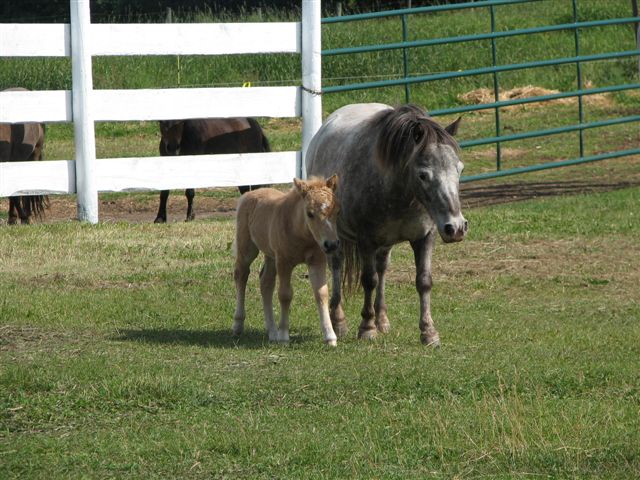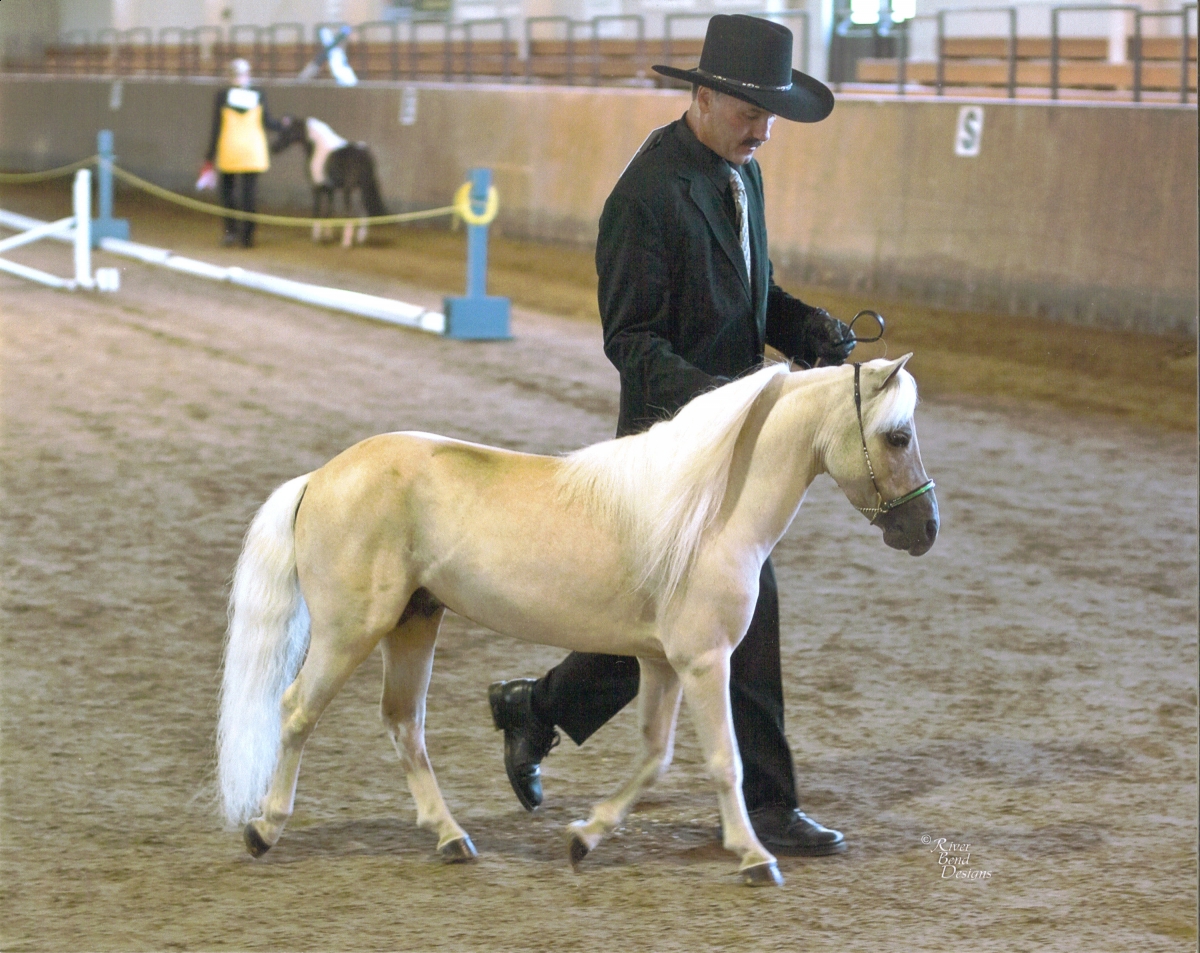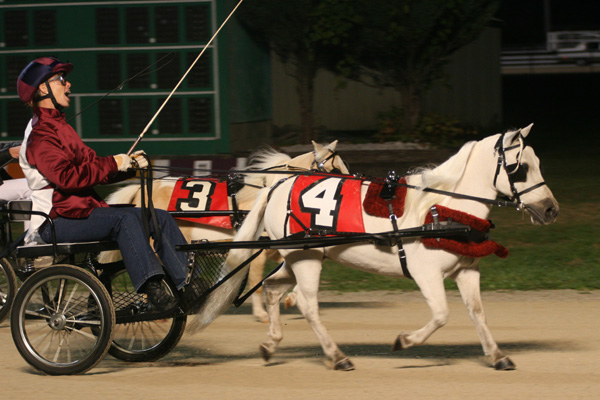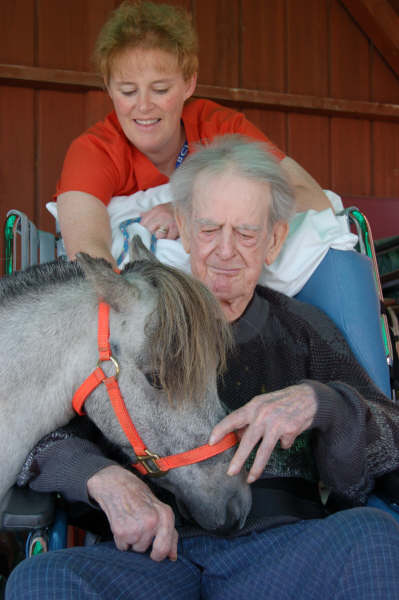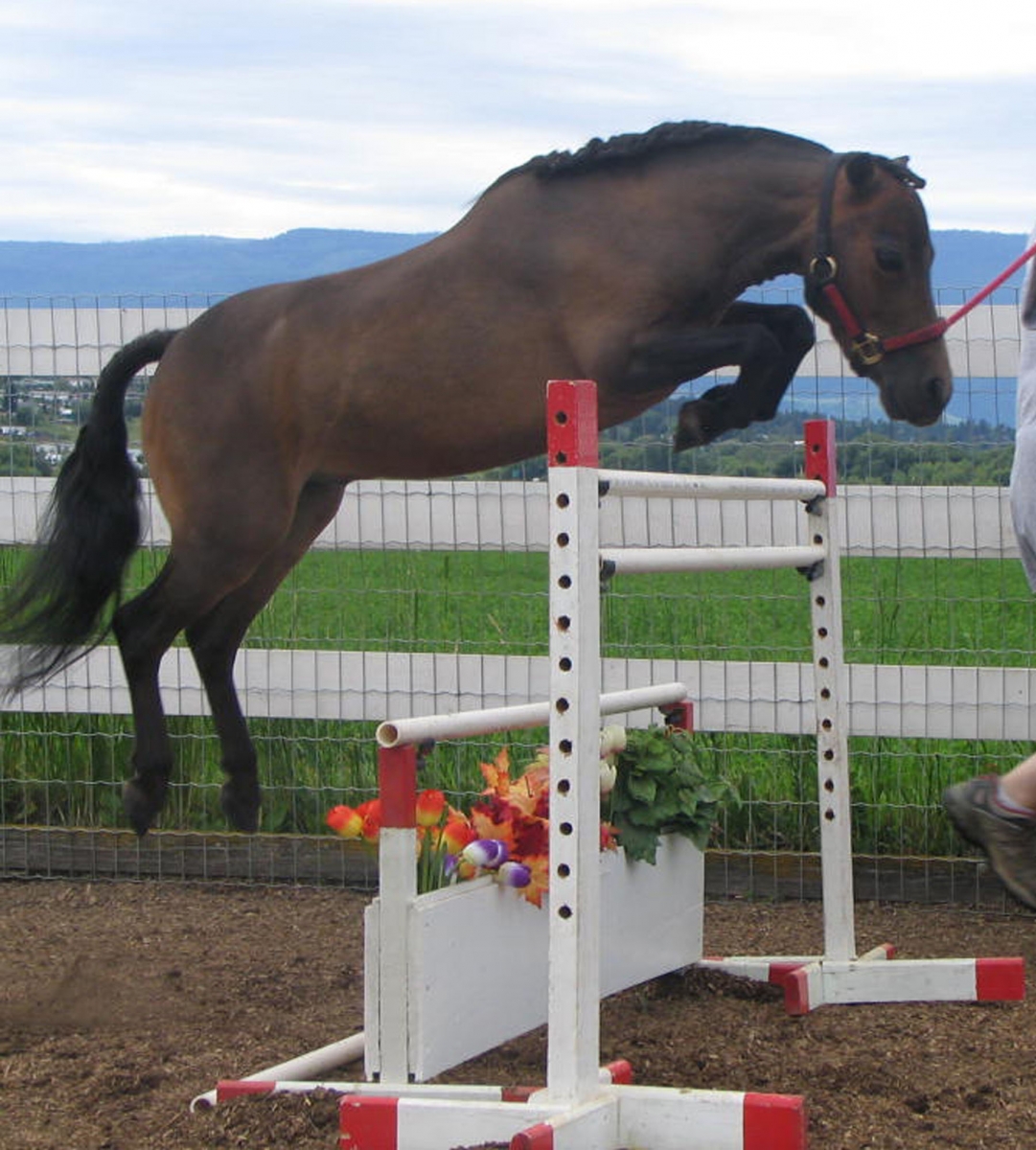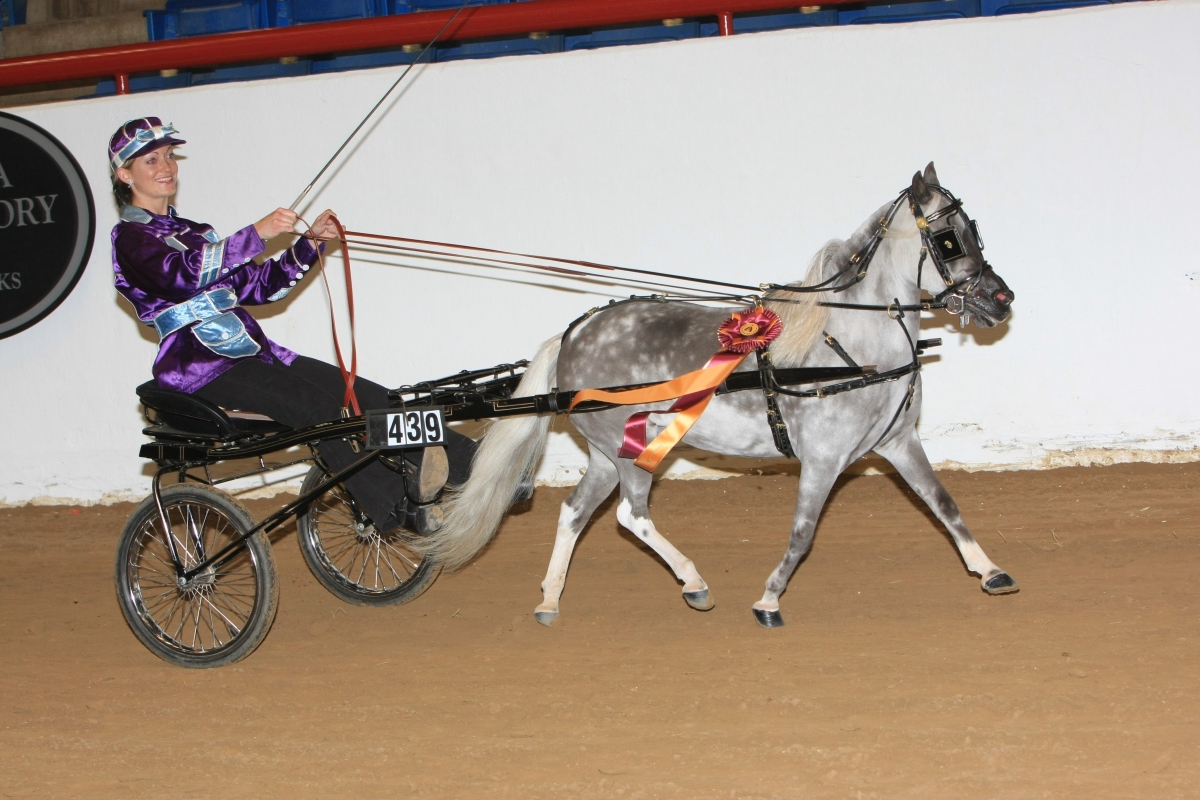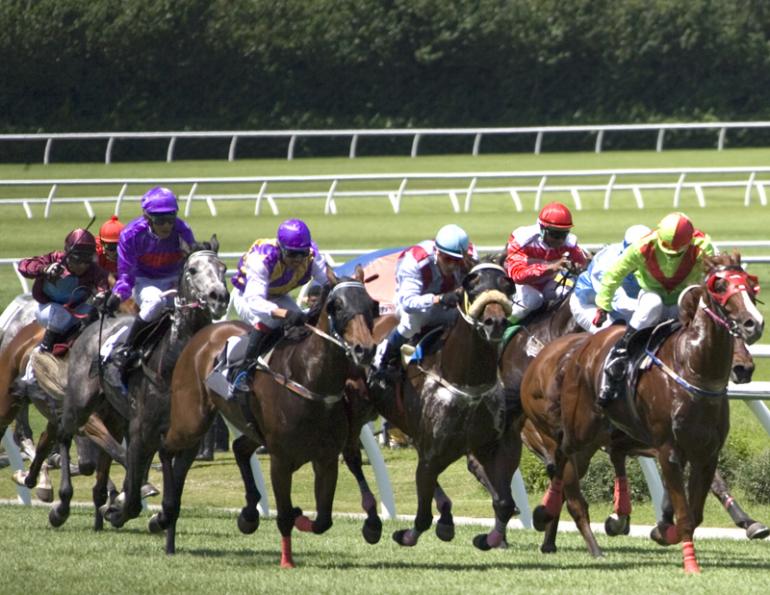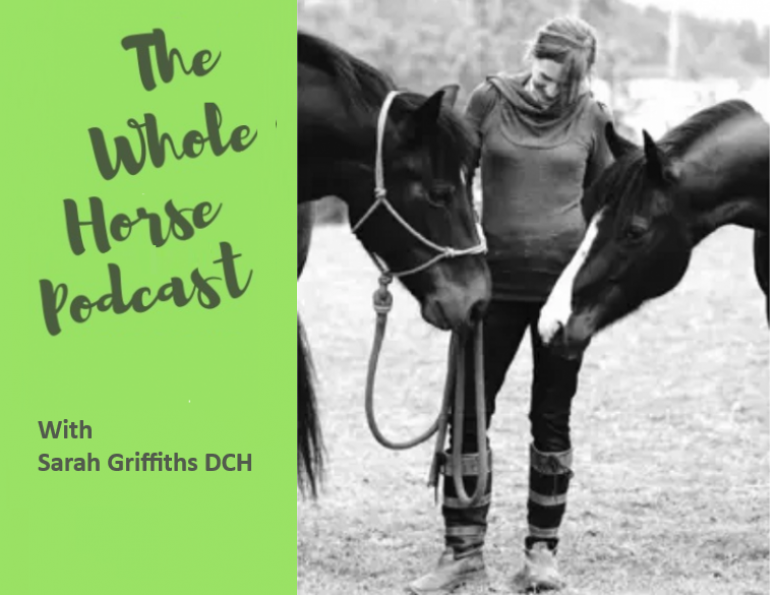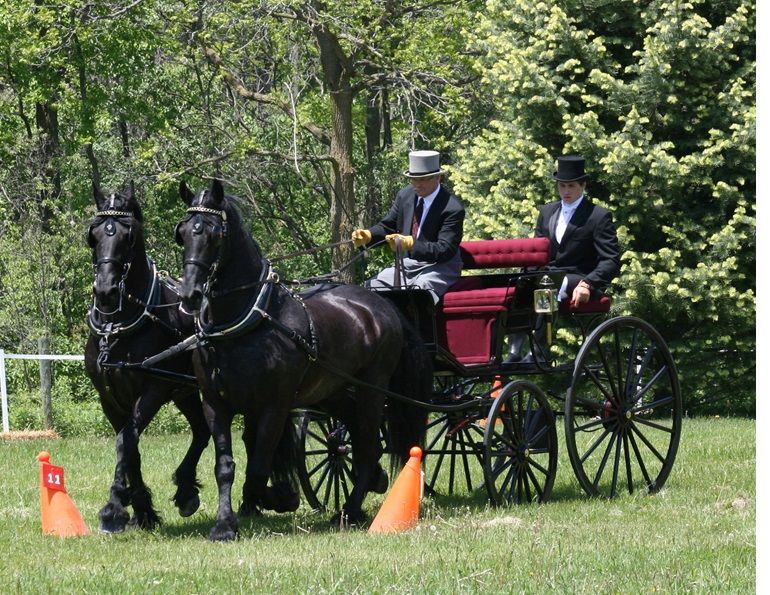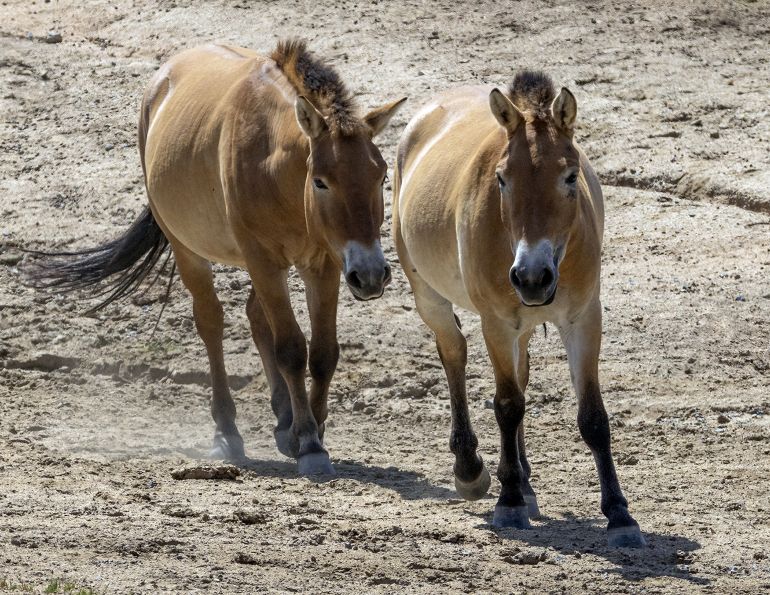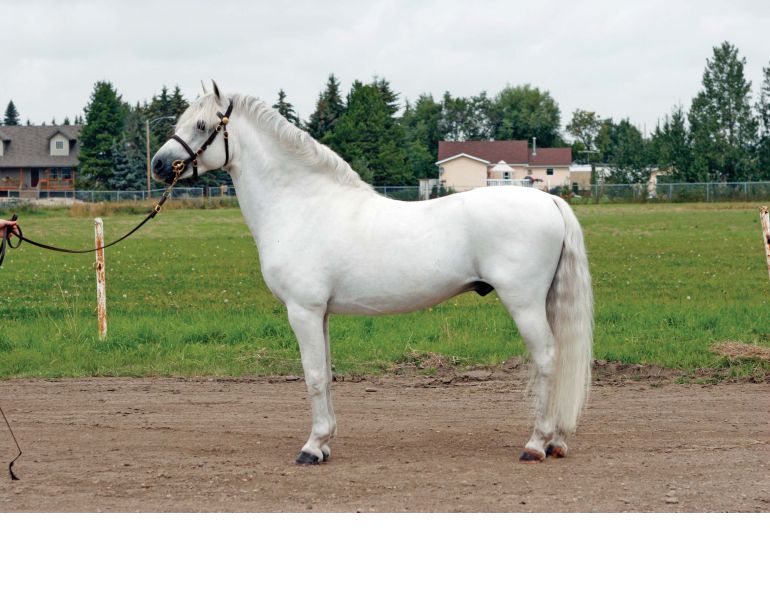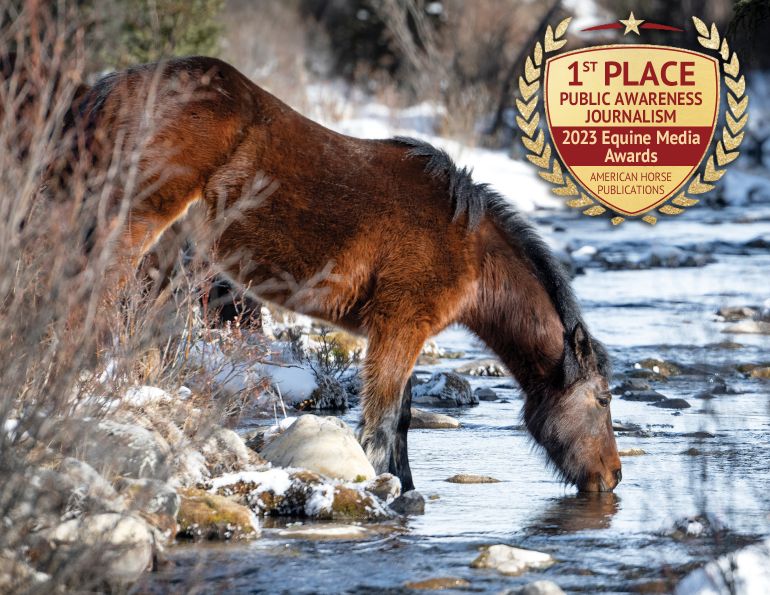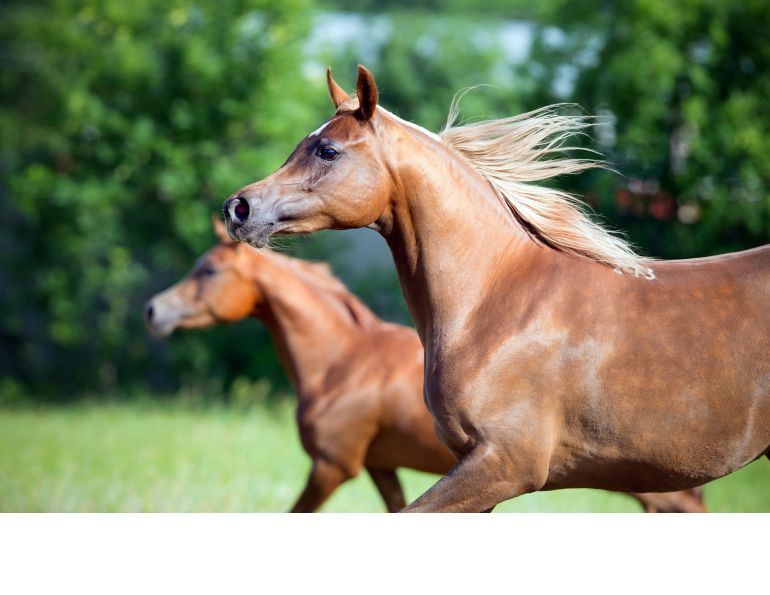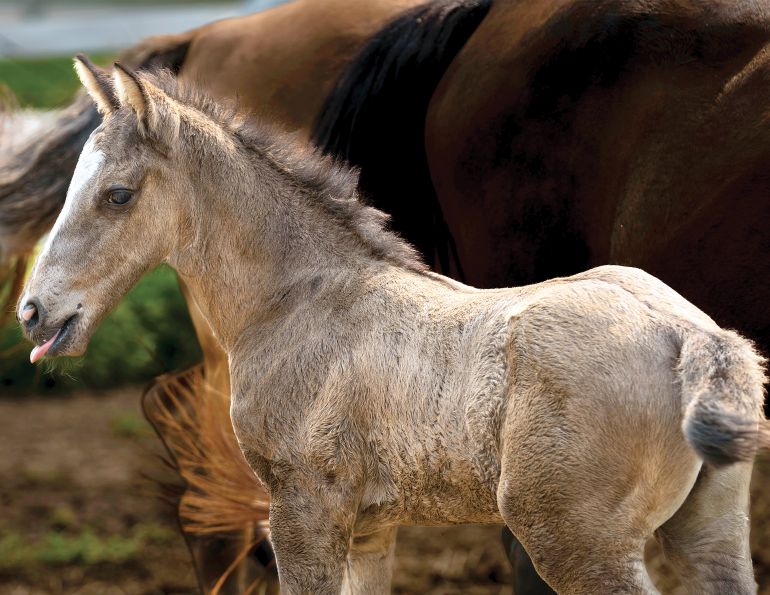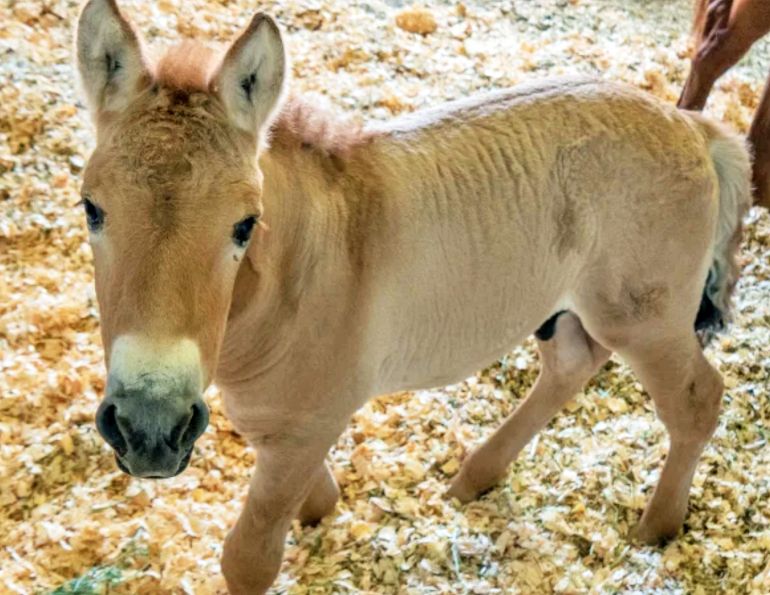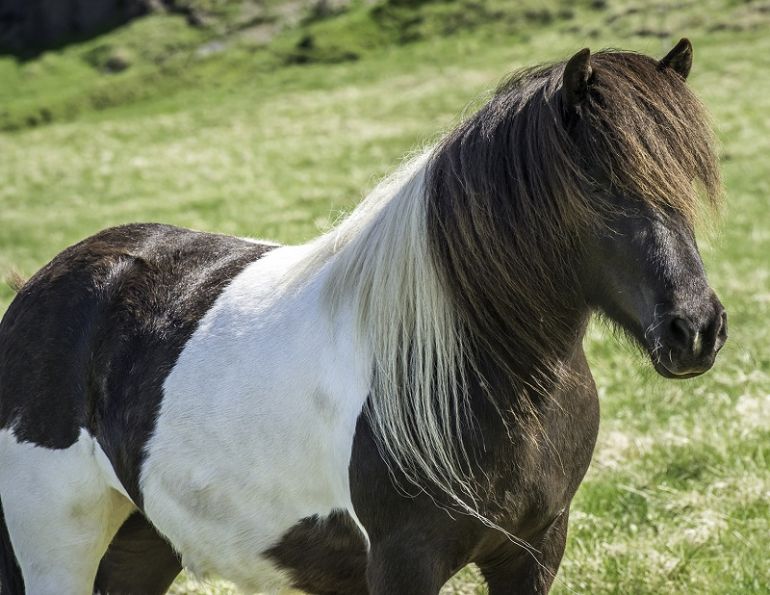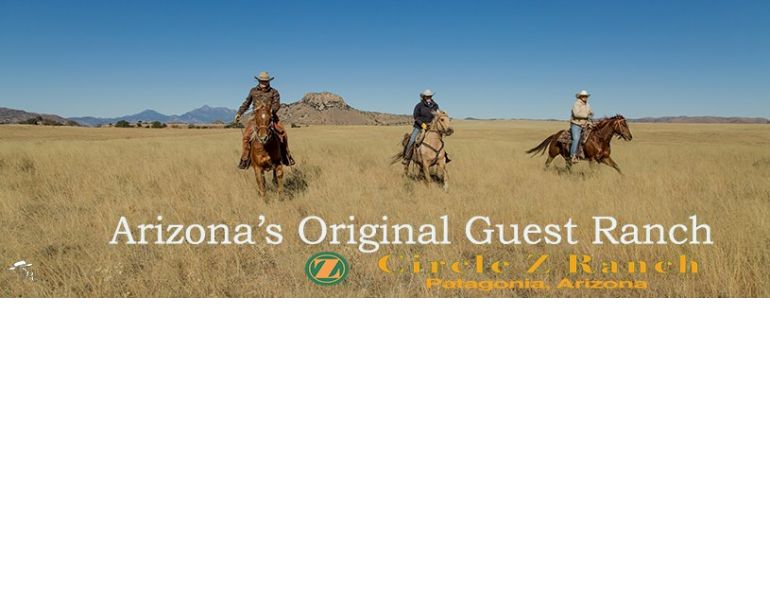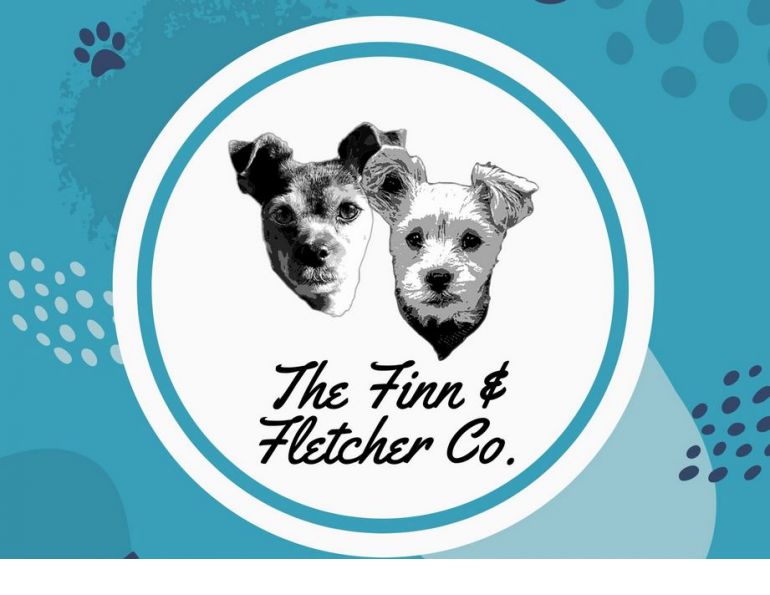By Caitlin MacDonald
See below for article sidebar - Equine Dwarfism
Many regard the Miniature Horse as an oddity or as a novelty. When a person first encounters a Miniature Horse, he will often exclaim one of two things: “Look at the cute little pony!” or “What do you DO with them?”
The latter is often asked by “big” horse fans, and anyone involved with “minis” as they are so affectionately called is only too happy to expound the virtues of their teeny equines. The answer to the question is “everything you can do with a big horse... and more!” The Miniature Horse is becoming increasingly well known, and as its profile increases so does its popularity. Young or old, few can resist the charm of the Miniature Horse.
A Short History
Throughout history, several distinct types of small horses have been developed around the world, using varying methods of selective breeding.
|
Photo: Pam MacKenzie |
Records show that the earliest miniature horses were bred as novelties for royalty.
During the Han dynasty, tiny Guoxia ponies were used as playthings in the Chinese Imperial courts. The Guoxia still exists today, a rare breed never reaching over 11 hands high. In Europe, the earliest mention of miniature horses is in 1650 A.D., where small equines were featured in the Royal Menagerie of King Louis XIV at the Palace of Versailles; and it is rumoured that Europe’s Habsburg nobility kept several miniature horses as pets. It is more than likely that these royal pets were the smallest of Shetland Ponies; in England, the South Park Shetland Pony Stud bred ponies for both Queen Victoria as well as the last Empress of Russia.
In 1868, the rare Falabella miniature horse was developed in Argentina using the smallest of Criollo stock horses, Welsh and Shetland Ponies, and even small Thoroughbreds. The breed was eventually standardized to heights under 40 inches, averaging 32 inches tall, and retaining the conformation of a full-sized horse. And in South Africa in 1945, Shetlands were bred down to heights under 27 inches tall.
|
Photo: Pam MacKenzie |
The earliest reports of miniature horses in the United States date to the early 1880s when such horses were included in shipments from Europe. A Virginian named Norman Fields purchased some of these tiny oddities and in the course of 50 years was producing horses as small as 75 centimeters in height.
Tiny horses were common as sideshow attractions at that time, but these were often horses with equine dwarfism, a debilitating genetic disease expressed in small, malformed horses with a shortened lifespan.
While there seem to be a variety of sources for the Miniature Horse known and loved in North America today, popular belief is that they primarily developed from the 18th century “pit pony.” Pit ponies were bred small for work hauling coal in underground mines.
The ponies had to be surefooted and levelheaded, as mine work could be dangerous. Pit ponies would typically work an eight hour day, and were stabled in the coal mines; many never came above ground their entire working lives. Many of the mine workers were employed alongside the ponies for the majority of their lives, and the ponies became their loved companions.
|
Photo: Courtesy of Faith Hambrook |
Shetland Ponies were most commonly used in the pits, as the height of the breed was considerably smaller in that era; the first American Shetland Pony Club (ASPC) stud book, established 1888, records the average Shetland’s height as only slightly over 40 inches, with 25 percent of them measuring 38 inches tall. A few of the early registered Shetlands only measured between 28 and 34 inches tall.
In the 19th century, pit ponies were regularly imported from Britain and the Netherlands to work in Appalachian coal mines. When the mines slowly became mechanized in the 1940s and 50s, they began to sell off their pit ponies.
Some enterprising breeders went around and bought all the smallest. In the beginning, they were only interested in small size, but then they began to focus their breeding goals in pursuit of more elegant, horse-like conformation.
Breeders sometimes used imported English, Dutch, Belgian, and German miniatures, while some selectively bred Miniatures using Hackney Ponies and Pony of the Americas, as well as larger horse breeds.
|
Photo: Courtesy of Susan Walters |
A Horse, of Course
In 1971, the ASPC opened up a registry division for Miniature Horses: the American Miniature Horse Registry (AMHR).
To qualify for registration, animals had to be under 34 inches in height at maturity, and were to resemble full-sized horses in proportion and conformation.
The open period of registration of foundation stock ran for two years, and after that period only horses produced by crosses of registered stock were allowed to be registered.
Shortly after, in 1978, the American Miniature Horse Association (AMHA) was incorporated, officially establishing the Miniature Horse as a distinct breed.
|
Photo: Courtesy of John and Arlene McCallum |
The AMHA standard of perfection describes a soundly conformed horse in miniature; the general impression should be one of symmetry, strength, agility, and alertness.
Moreover, the goal of the Miniature Horse breeder is to “miniaturize” the same desired conformation and characteristics of a full sized equine.
Through careful selection over the years, breeders have erased almost all pony characteristics from the breed, achieving, as stated in the AMHA standard of perfection, a “sound, well-balanced horse, possessing the correct conformation characteristics required of most breeds” under 34 inches tall. A Miniature Horse’s height is measured differently from other horse breeds: from the last hair on their mane to the ground, rather than from their withers.
In 1986, due to popular demand, the AMHR voted in a “B” division, which registers Miniature Horses from 34 inches up to 38 inches tall, as some breeders were getting good horses over the allowable height limit.
|
Photo: Katz Photography, Courtesy of Joan McNaughton |
In addition, some breeders are reintroducing Shetland Pony lines to the breed, producing minis which are registered with both AMHR and ASPC.
Miniature Horses are to be well-muscled, balanced, and well-proportioned, with a streamlined appearance.
The neck should be flexible and lengthy, and the throat-latch well-defined, allowing ample flexion from the poll. The horse should have a long sloping shoulder allowing flowing movement, a deep girth and flank, and a trim barrel. Straight, correct legs are a must.
As the breed standard of perfection describes characteristics desired of most full sized horses, one can find differing types within the Miniature Horse breed: some prefer “Arabian type,” some prefer “Quarter Horse type,” and still others prefer minis that resemble the draft breeds in conformation.
Some also breed for colour, with loud-coloured paints, appaloosas, and cremellos being a preference.
Any colour is acceptable in the breed, and Miniature Horses are notorious for their wide varieties of colours, patterns, and markings that one would rarely see in amongst larger horse breeds.
|
Photo: Iron Horse Photo Inc., Courtesy of Carolyn Aarup |
The variety in type illustrates the success breeders have had creating full-sized horses in miniature. The breed is consistent and correct, a far cry from the curious tiny ponies called miniatures through history.
“I believe that it would be harder today to buy a poor quality Miniature Horse than a good quality mini.
The overall look, style, and conformation of minis have become so good that being a judge must surely be a challenge,” says Gerry Breckon, Region 10 (western Canada) AMHA Director.
|
Photo: Courtesy of Peter and Terry Holt |
Made in Canada
Canadian breeders have made serious contributions to improving the breed. One such breeder is KC Pappas of Calgary Alberta.
Her stallion First Knights Bit O Hot Shot was the unanimous decision for 1992 AMHA World Grand Champion Junior Stallion, and the 2007 Top Futurity sire.
“Hot Shot” is also the sire of First Knights Redi or Not, the 1999 AMHA World Grand Champion Senior Stallion, and 2007 World Reserve Champion Get of Sire; and First Knights Lord of the Ring, the 2005 AMHA World Grand Champion Senior Stallion, and 2007 AMHA Reserve World Champion Senior Stallion.
Hot Shot also sired the 2007 AMHA World Champion Open Futurity Winner First Knights Divine Diva, and Open Futurity Grand Champion First Knights Return of the King. These horses are making their mark on the Miniature Horse industry, and appearing in many champion pedigrees. “We thank KC Pappas for her strict breeding program and her very high standards,” says Breckon, who now owns First Knights Return of the King.
|
Photo: Debbie and Heather Scriven |
The Horse for Everyone
Miniature Horses are very intelligent, trainable, and willing. “There are always people who think they’re mean and ornery,” says Kendra Gale of Circle J Ranches in Cochrane, Alberta.
“I think it comes from kids who had small ponies who were smarter than they were! Miniature Horses tend to be very willing and sociable, and extremely smart. Obviously, as with any breed of horse, every individual has their own personality.”
Miniature Horses are a good introduction to horses, and a natural option for small children, who may begin their equestrian careers by learning solid horsemanship with a Miniature Horse.
“I think it’s fascinating watching youth progress with these horses,” says John McCallum, vice-president of the Miniature Horse Club of Ontario (MHCO). “They feel confident, and their parents feel confident that their young children can work with these horses.”
“My farrier told me about a little mini for sale and thought my kids might like something their size to handle,” says Carolyn Aarup, Treasurer and Public Relations Coordinator for the MHCO, about her introduction to the breed.
|
Photo: Robin Duncan Photography |
“It was me that fell in love with him [the mini] and then got into Miniatures!”
Those who love horses but feel intimidated by full-sized breeds may feel comfortable working with minis.
“After 25 years in the city, my wife and I moved to the country and wanted to get horses. We’d never had livestock before, and after looking around and researching we decided Quarter Horses weren’t for us. We discovered minis, bought two, and from there our farm has grown,” McCallum recounts.
Similarly, the physically disabled and older enthusiasts who can no longer physically manage a full sized mount may turn to the enjoyment of a Miniature Horse. Their small size and sweet nature make the breed popular for equine therapy. Miniature Horses bring comfort to the disabled and those in nursing homes and hospitals.
“The most common question we are asked is ‘what are they good for?’” says Breckon.
“To us it is simple — they are good for everything.”
Showing Miniature Horses
The wide range of classes featured at Miniature Horse shows highlights the versatility of the breed. Besides the standard conformational judging of a halter class, Miniature Horse shows offer classes that test both handler and horse in partnership and performance.
|
Photo: Courtesy of Joan Cunningham |
Horses are shown in showmanship, halter obstacle (an in-hand version of a Western trail class), hunter (horses are shown in-hand and judged according to cadence, balance, and form), jumper (minis have been known to clear heights of over 44 inches), costume, liberty, and a variety of driving classes.
Community, camaraderie, and support are strong at Miniature Horse shows. “If anyone has any questions or anything is going wrong, there is always somebody who jumps in to give a hand. I’ve talked to people who show in other disciplines and they couldn’t believe how fun and friendly the MHCO shows are,” says McCallum.
“We sold a filly to a woman in her mid 50’s and helped her prepare it for her first show,” recounts Breckon. “She of course was nervous as she entered the ring but she proudly did her best and showed the filly with all her heart. She was awarded with a first place and literally had tears [of joy] streaming down her face. It was the first time she had ever won anything in her life. I have had this experience repeated many times with folks of all ages as they started their mini lifestyle and see the power of the Miniature Horse to change people’s lives,” says Breckon.
|
Photo: Equine Imagery |
Serious Horsepower
Miniature Horses are talented performance horses.
While they are too small to be ridden save for the smallest child (according to AMHA, Miniature Horses should not be ridden by anyone over 70 pounds), their talent between the shafts of a cart is impressive. In the show ring,
Miniature Horses compete in obstacle driving, displaying their willingness and trainability, and in country pleasure, single pleasure, roadster, park, and hitch classes.
Miniature Horses are by no means slow, plodding ponies; their stamina, carriage, movement, and way of going rival the abilities of any large driving breed.
“We drive for pleasure, for show, and even do Miniature Horse harness races!” says Aarup.
|
Photo: Courtesy of Joy Viel |
“People who are accustomed to full-sized horses often think they’re cute, but wonder what good they are," says Gale.
However, the power of Miniature Horses often wins over people: "the athletic ability and willingness of the Miniature Horse has converted a number of staunch big horse owners, as soon as they spend some time in a cart behind a well trained driving horse,” says Gale.
The current breed trend is towards horses at the top of the height limit, with longer legs and flashy action.
“We try to raise all-around horses, those that can be competitive in halter, driving, jumping, obstacle, and anything else you want to do with them. As a result, we prefer our horses near the top of the 34 inch AMHA height limit,” says Gale.
Top Miniature driving horses are in big demand.
“Driving is huge in the Ottawa, Ontario area,” says McCallum. “I’m beginning to see more focus on performance horses. I know of a breeder who has shipped several good driving horses to Nova Scotia."
|
Photo: Equine Imagery |
Further, as McCallum notes, "the trend in eastern Canada is towards B division minis that are competitive in driving. They have a lot of nice movement to them — fluid motion.”
Far more than pasture pets, Miniature Horses are extremely versatile and athletic, and their small size makes them welcome in many places where larger horses may not be.
Whether driving in a flashy cart, bringing comfort to the disabled, introducing children to the world of horses, or simply bringing joy to their owners at home, the Miniature Horse is proving to people across Canada that they are much more than a curiosity.
Equine Dwarfism
By Caitlin MacDonald
Equine dwarfism is characteristically high in the Miniature Horse population. Equine dwarfism is a relatively rare occurrence in large horses, but it can be more common in Miniature Horses that have been bred exclusively for small size. In the opinion of many veterinarians, all miniature horses and ponies possess some of the genetic markers for dwarfism. Others believe that dwarfism is only present in pedigrees where dwarf horses have intentionally been bred in order to reduce size.
Animal research indicates that there are more than 320 separate and distinct types of dwarfism, each with a unique genetic marker and characteristics. Dwarfism can express itself in several ways including a large head with a domed forehead, short or twisted legs, unusually short or long back, potbelly, and/or a malformed jaw often with an underbite. The severity of the gene’s expression varies, with some horses being affected only in undesirable appearance, and others being so severely malformed as to live short and painful lives.
Nowadays, it is against AMHA and AMHR policy to register dwarves, and many enthusiasts look down on Miniatures with dwarf characteristics. “With careful and select breeding, this trait can be reduced or even eliminated from the Miniature Horse breed, but this depends on the breeders,” says Aarup.
“Interested people stop in all the time looking to buy when they see my horses grazing from the side of the road. They may be well intentioned, but I have turned down many offers for my horses because I didn’t feel it was a good match. We need to be responsible so as not to hurt the breed or individual horses,” says McCallum.
Main article photo: Robin Duncan Photography - A common question asked of Miniature Horse owners is “what are they good for?” The answer is “everything!”



